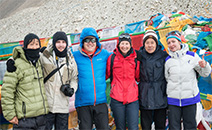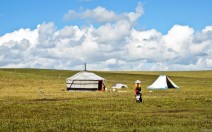In the mind of most travelers, Tibet is a remote region tucked away in the Himalayan mountains. Long isolated from the rest of the world, Tibet was a forbidden land impossible to enter. But now Tibet is easier to access than ever. Here’s some advice on getting there.
Tibet Travel Permits
All travelers to the Tibet Autonomous Region require Tibet Travel Permits. In order to get a Tibet Travel Permit, travelers must arrange a tour through a travel agency. The required elements of even the most basic tour include a permit, a guide, and if you leave Lhasa, a car and driver.
Entering Tibet via mainland China
If you enter the Tibet Autonomous Region via mainland China, you will need a Chinese visa as well as a Tibet Travel Permit. Once in China, your travel agency will send you your permit. If you are traveling by train to Tibet, you only need a copy of your permit, which your travel agency will send you via email. If you are traveling by plane to Tibet, you will need your original permit, which your travel agency will send to your hotel via courier mail.
By Train
Lhasa is accessible by train from Xining, Lanzhou, Chengdu, Xi’an, Beijing, Shanghai, and Guangzhou, as well as numerous other cities along the railway.
By Air
Lhasa is accessible by plane by Chengdu, Xi’an, Shangri-la, Beijing, Shanghai, Guangzhou, Chongqing, Xining and a number of other Chinese cities.
By Land
Lhasa is accessible by car by the Qinghai-Tibet Highway, the Sichuan-Tibet North Highway, the Sichuan-Tibet South Highway, and the Yunnan-Tibet Highway.
It is also possible to travel from Kashgar into Western Tibet (Ngari) via the Xinjiang-Tibet Highway.
Click here for a Sketch Map of Overland Routes to Tibet.
Entering Tibet via Nepal
If you enter the Tibet Autonomous Region via Nepal, you will need to go through an agency to apply for a “group visa” that will allow you to enter Tibet. If you already have a Chinese visa, it will be canceled and you will instead be issued a “group visa.” These “group visas” exist on separate pieces of paper outside your passport and include a list of all of the travelers’ names. “Group visas” are typically 15-25 days and they cannot be changed or extended while in Tibet. All group members on the visa must exit China at the same time.
By Air
There are regular flights from Kathmandu to Lhasa. Along the way, enjoy a spectacular view of the Himalayas.
By Land
Traveling overland from Kathmandu, it takes 5-7 days to reach Lhasa. Along the way, pass by Everest Base Camp, Tingri, Gyantse, and Shigatse.
Traveling to Other Tibetan Regions in China
While travel to the Tibet Autonomous Region is heavily restricted, there are many other Tibetan regions that can be visited with much less hassle. These regions, known in Tibetan as Amdo and Kham, are located on the eastern edge of the Tibetan plateau and are spread over the Chinese provinces of Qinghai, Sichuan, Gansu, and Yunnan. Travelers to these regions do not require any special permits, guides, or cars and drivers. In addition, foreigners are allowed to take public transportation in these areas. However, if you do not speak the local languages, it is recommended that you hire a guide or at least bring a Tibetan/Chinese language phrasebook.
Xining serves as the gateway for most trips to Amdo, Chengdu as the gateway for most trips to Kham.
Tibet Travel Agencies
As you will need to contact a travel agency to arrange Tibet Travel Permits and a Tibet tour, how do you know which one to choose? It is best to select an agency that specializes in Tibet and is based in Lhasa, Xining, or Chengdu. These agencies are generally experienced in arranging Tibet travel and offer the most reasonable prices. Agencies that do not have their own offices in these cities act as middle-men that jack up prices, so it is better to contact local agencies directly.
It is recommended that travelers to Tibet choose Tibetan-owned companies. Tourism is an important business in Tibet, and by supporting local Tibetan-owned companies, you can rest assured that your tourism dollars go straight to Tibetan communities. Tibetans invariably know their own land and culture better than non-locals who set up travel agencies in Tibet, and they also arrange local Tibetan guides and drivers and accommodation at Tibetan-owned hotels. If responsible travel is important to you, support local businesses by patronizing Tibetan travel agencies and businesses.
SnowLion Tours is a Tibetan-owned and operated travel company.
Here are some other posts that might interest you:
- Famous Monasteries in Lhasa
- Lhasa Highlights
- Lhasa Day Trips
- Recommended Tibet Guidebooks
- Responsible Tourism in Tibet
For more information, please contact us at info@snowliontours.com






